Practice Free 300-410 Exam Online Questions
Refer to the exhibit.
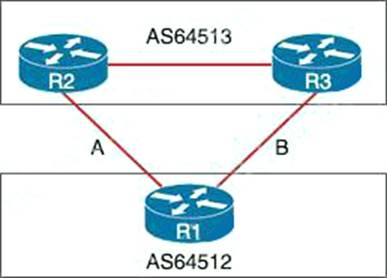
A network engineer for AS64512 must remove the inbound and outbound traffic from link A during maintenance without closing the BGP session so that there ………… a backup link over link A toward the ASN.
Which BGP configuration on R1 accomplishes this goal?
A)
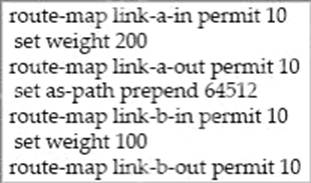
B)
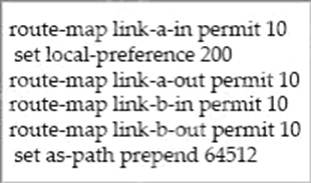
C)
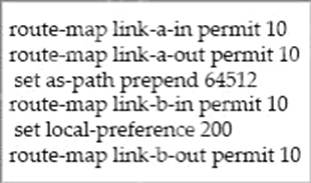
D)
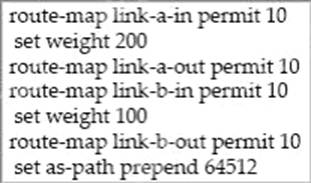
- A . Option A
- B . Option B
- C . Option C
- D . Option D
R2 has a locally originated prefix 192.168.130.0/24 and has these configurations:

What is the result when the route-map OUT command is applied toward an eBGP neighbor R1 (1.1.1.1) by using the neighbor 1.1.1.1 route-map OUT out command?
- A . R1 sees 192.168.130.0/24 as two AS hops away instead of one AS hop away.
- B . R1 does not accept any routes other than 192.168.130.0/24
- C . R1 does not forward traffic that is destined for 192.168.30.0/24
- D . Network 192.168.130.0/24 is not allowed in the R1 table
Refer to the exhibit.
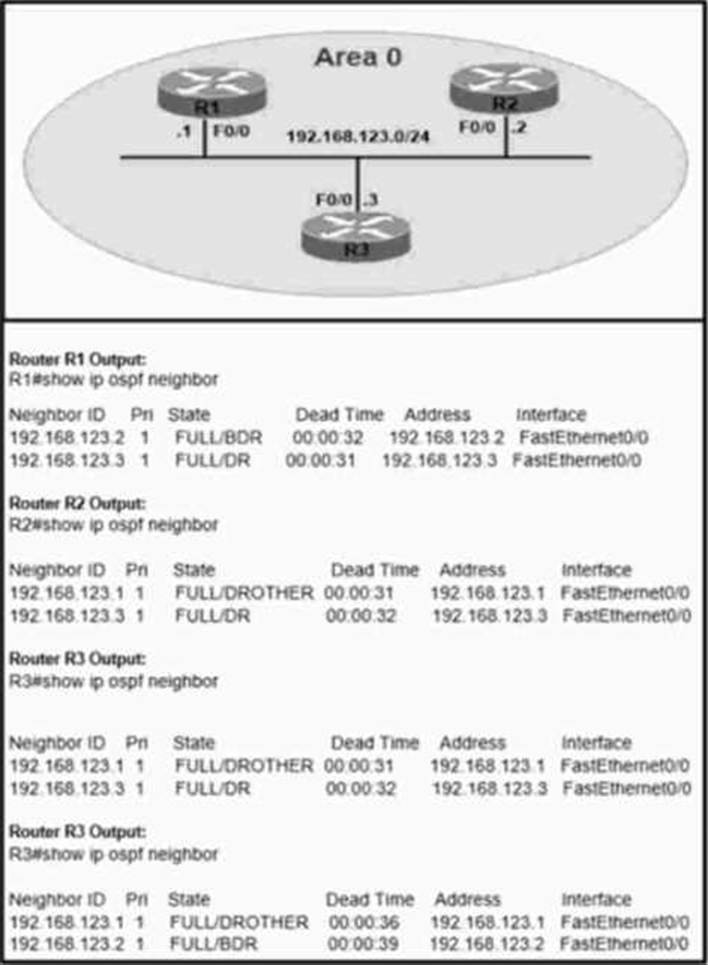
An administrator wanted to make R1 always elected as DR. R2 as BDR. and R3 as DROTHER but could not achieve the desired results.
Which two configurations resolve the issue? (Choose two.)
- A . On the R1 F0/0 interface, configure OSPF priority to 255.
- B . On the R2 F0/0 interface, configure OSPF priority to 201.
- C . On the R1 F0/0 interface, configure OSPF priority to 202.
- D . On the R3 F0/0 interface, configure OSPF priority to 201.
- E . On the R2 F0/0 interface, configure OSPF priority to 200.
Which option is the best for protecting CPU utilization on a device?
- A . fragmentation
- B . COPP
- C . ICMP redirects
- D . ICMP unreachable messages
Refer to the exhibit.
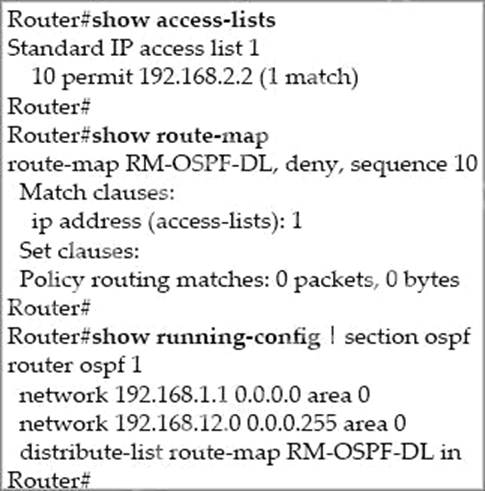
Which two actions should be taken to access the server? (Choose two.)
- A . Modify the access list to add a second line of permit ip any
- B . Modify the access list to deny the route to 192.168.2.2.
- C . Modify distribute list seq 10 to permit the route to 192.168.2.2.
- D . Add a sequence 20 in the route map to permit access list 1.
- E . Add a floating static route to reach to 192.168.2.2 with administrative distance higher than OSPF
The network administrator configured CoPP so that all HTTP and HTTPS traffic from the administrator device located at 172.16 1.99 toward the router CPU is limited to 500 kbps. Any traffic that exceeds this limit must be dropped.
access-list 100 permit ip host 172.16.1.99 any
!
class-map CM-ADMIN
match access-group 100
!
policy-map PM-COPP
class CM-ADMIN
police 500000 conform-action transmit
!
interface E0/0
service-policy input PM-COPP
CoPP failed to capture the desired traffic and the CPU load is getting higher.
Which two configurations resolve the issue? (Choose two.)
- A . interface E0/0
no service-policy input PM-COPP
!
control-plane
service-policy input PM-COPP - B . policy-map PM-COPP
class CM-ADMIN
no police 500000 conform-action transmit
police 500 conform-action transmit
!
control-plane
service-policy input PM-COPP - C . no access-list 100
access-list 100 permit tcp host 172.16.1.99 any eq 80 - D . no access-list 100
access-list 100 permit tcp host 172.16.1.99 any eq 80
access-list 100 permit tcp host 172.16.1.99 any eq 443 - E . policy-map PM-COPP
class CM-ADMIN
no police 500000 conform-action transmit
police 500 conform-action transmit
Refer to exhibit.
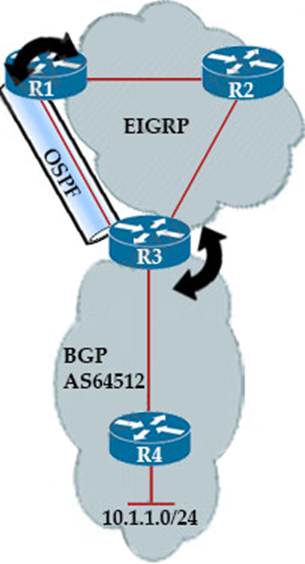
Routing protocols are mutually redistributed on R3 and R1. Users report intermittent connectivity to services hosted on the 10.1.1.0/24 prefix. Significant routing update changes are noticed on R3 when the show ip route profile command is run.
How must the services be stabilized?
- A . The issue with using BGP must be resolved by using another protocol and redistributing it into EIGRP on R3
- B . The routing loop must be fixed by reducing the admin distance of iBGP from 200 to 100 on R3
- C . The routing loop must be fixed by reducing the admin distance of OSPF from 110 to 80 on R3
- D . The issue with using iBGP must be fixed by running eBGP between R3 and R4
B
Explanation:
After redistribution, R3 learns about network 10.1.1.0/24 via two paths:
+ Internal BGP (IBGP): advertised from R4 with AD of 200 (and metric of 0)
+ OSPF: advertised from R1 with AD of 110 (O E2) (and metric of 20)
Therefore R3 will choose the path with the lower AD via OSPF But this is a looped path which is received from R3 -> R2 -> R1 -> R3. So when the advertised route from R4 is expired, the looped path is also expired soon and R3 will reinstall the main path from R4. This is the cause of intermittent connectivity. In order to solve this issue, we can lower the AD of iBGP to a value which is lower than 110 so that it is preferred over OSPF-advertised route.
Refer to exhibit.

Routing protocols are mutually redistributed on R3 and R1. Users report intermittent connectivity to services hosted on the 10.1.1.0/24 prefix. Significant routing update changes are noticed on R3 when the show ip route profile command is run.
How must the services be stabilized?
- A . The issue with using BGP must be resolved by using another protocol and redistributing it into EIGRP on R3
- B . The routing loop must be fixed by reducing the admin distance of iBGP from 200 to 100 on R3
- C . The routing loop must be fixed by reducing the admin distance of OSPF from 110 to 80 on R3
- D . The issue with using iBGP must be fixed by running eBGP between R3 and R4
B
Explanation:
After redistribution, R3 learns about network 10.1.1.0/24 via two paths:
+ Internal BGP (IBGP): advertised from R4 with AD of 200 (and metric of 0)
+ OSPF: advertised from R1 with AD of 110 (O E2) (and metric of 20)
Therefore R3 will choose the path with the lower AD via OSPF But this is a looped path which is received from R3 -> R2 -> R1 -> R3. So when the advertised route from R4 is expired, the looped path is also expired soon and R3 will reinstall the main path from R4. This is the cause of intermittent connectivity. In order to solve this issue, we can lower the AD of iBGP to a value which is lower than 110 so that it is preferred over OSPF-advertised route.
Refer to the exhibit.
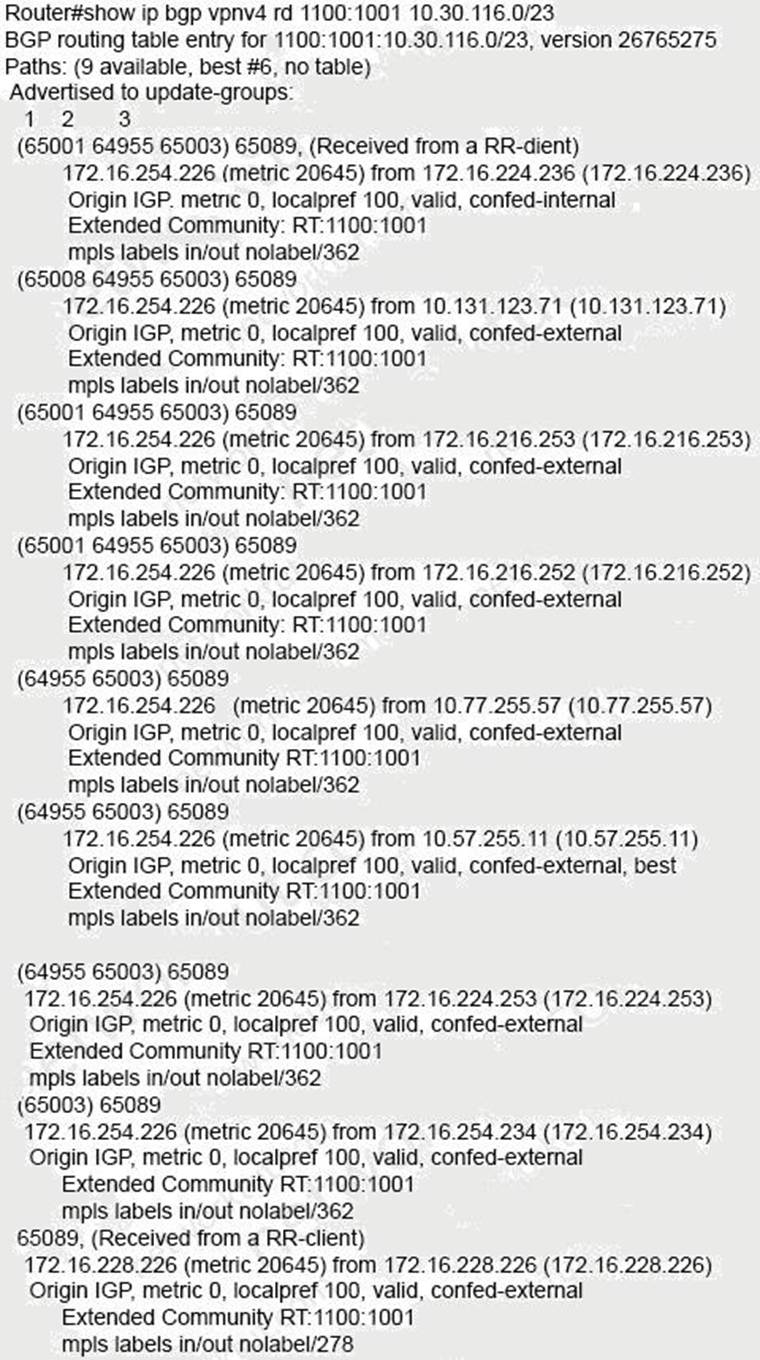
An engineer configured BGP and wants to select the path from 10.77.255.57 as the best path instead of current best path.
Which action resolves the issue?
- A . Configure AS_PATH prepend for the desired best path
- B . Configure higher MED to select as the best path.
- C . Configure lower LOCAL_PREF to select as the best path.
- D . Configure AS_PATH prepend for the current best path
Refer to the exhibit.

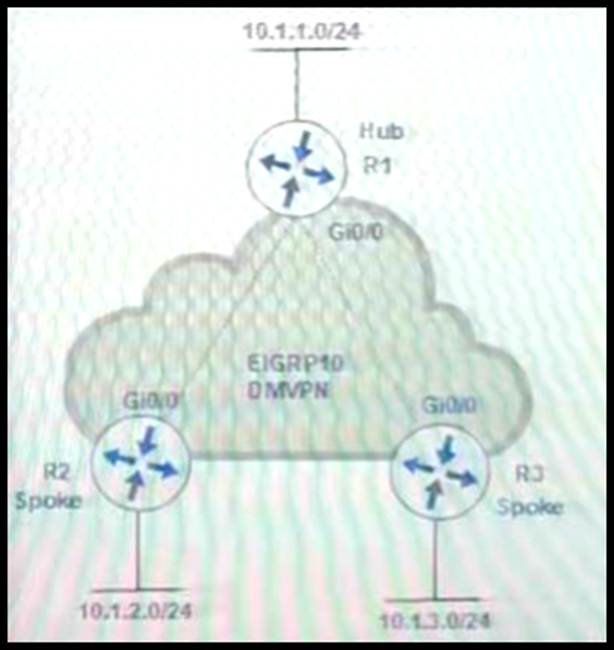
An engineer configures DMVPN and receives the hub location prefix of 10.1.1.0724 on R2 and R3 The R3 prefix of 10 1.3.0/24 is not received on R2. and the R2 prefix 10.1,2.0/24 is not received on R3.
Which action reserves the issue?
- A . Split horizon prevents the routes from being advertised between spoke routers it should be disabled with the command no ip split-horizon eigrp 10 on the tunnel interface of R1
- B . There is no spoke-to-spoke connection DMVPN configuration should be modified to enable a tunnel connection between R2 and R3 and neighbor relationship confirmed by use of the show ip eigrp neighbor command
- C . Split horizon prevents the routes from being advertised between spoke routers it should be disabled with the no ip split-horizon eigrp 10 command on the Gi0/0 interface of R1.
- D . There is no spoke-to-spoke connection DMVPN configuration should be modified with a manual neighbor relationship configured between R2 and R3 and confirmed bb use of the show ip eigrp neighbor command.
A
Explanation:
In this topology, the Hub router will receive advertisements from R2 Spoke router on its tunnel interface. The problem here is that it also has a connection with R3 Spoke on that same tunnel interface. If we don’t disable split-horizon, then the Hub will not relay routes from R2 to R3 and the other way around. That is because it received those routes on the same interface tunnel and therefore it cannot advertise back out that same interface (split-horizon rule). Therefore we must disable split horizon on the Hub router to make sure the Spokes know about each other.
